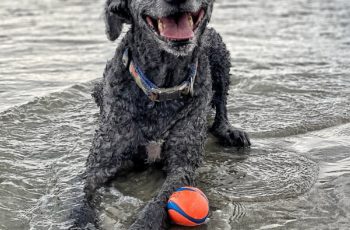Don’t panic. However, this is hard to tell any pet parent with a dog with vestibular disease.
The syndrome may occur in old dogs and is idiopathic if there is no reason or diagnosis of an inner ear infection. This was the case with our older dog, Shermie. He started to vomit and lose his balance. This disease resolved, and then a few days later, this happened again but worse. Another symptom was nystagmus, where his pupils moved back and forth quickly, causing total imbalance for days. Shermie had a bad case of vertigo.
Shermie needed assistance to walk, eat, and move around naturally. Over about five weeks, this resolved on its own with supportive care. Hang in there, and I have some tips. Sherm is 14-years-old and doing ok, but this hit him hard.
Supportive care for a dog with vestibular syndrome

Credit: Kaylee Photography 2020
What is vestibular disease?
According to VCA Hospitals, “Causes of vestibular disease include middle or inner ear infections, drugs that are toxic to the ear, trauma or injury, tumors, and hypothyroidism. When no specific cause is found, the condition is called idiopathic vestibular syndrome. These cases are distinguished by the sudden onset of clinical signs and the subsequent rapid improvement with little, if any, medical intervention.”
Our holistic vet and GP recommended supportive care and a drug called Cerenia. This is where we started, and Sherm was in fairly bad shape. Cerenia is a drug for motion sickness, and this is what you need to get your best friend back on track.
- Cerenia every 12 hours. This immediately helped Shermie settle, and he could almost stand without falling over. Without Cerenia, I’m not sure Sherm may have bounced back as quickly as he did.
- A harness: We kept his harness on 24/7, so he could walk outside without falling over, and we could safely walk him down a ramp in the backyard.
- The nystagmus didn’t resolve for many days. Our holistic vet mentioned that Sherm felt like he was on a roller coaster and couldn’t get off. Can you imagine? We also increased his gabapentin, a drug for chronic pain he already takes and has sedating effects. The hope is that he would sleep and rest with the increased dose. It helped.
- Eating and inappetence are real: Sherm was so nauseous for days we hand fed him, which helped… a lot. We cooked ground turkey and used canned food to help entice him to eat.
- An appetite stimulant was unnecessary, but mirtazapine was our plan b if Sherm didn’t want to eat even after we tried “all the things,” but I highly recommend using this if you’re struggling.
Your dog will likely experience vertigo for days and may even have a head tilt. Sherm’s head tilt was to the left, and this bothered him. The head tilt is gone. In some cases, for dogs with this condition, it may never disappear. One of Sherm’s favorite behaviors is to shake. He shakes after he eats and when he returns from pottying outside. This wasn’t a behavior he could do anymore without falling over. He couldn’t lie on his side on the dog bed. Sherm wasn’t himself.
We all hung in there. I helped him outside to potty and made sure he was getting enough to eat with his Cerenia and pain medications. After about five or six weeks, Sherm looks excellent, and just as our holistic vet mentioned, it’s like the wind. Vestibular disease disappears overnight. Pet parents need to be patient, and your dog will return to normal.
Don’t panic.



